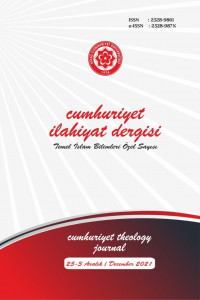Tefsirde Tahsis: Muḳātil b. Suleymān’ın Kitāb-ı Muḳaddes’in Tahrifine Dair Âyetleri Hz. Muhammed’in Tebşiri Özelinde Yorumlaması
Takhṣīs in the Tafsīr: Muḳātil b. Sulaymān’s Interpretation of Verses regarded with Falsification of Bible in the Context of’s Muḥammad’s Tabs̲h̲īr
Author(s): Ayşe UzunSubject(s): Semiotics / Semiology, Islam studies, Semantics, Hermeneutics, Qur’anic studies
Published by: Cumhuriyet Üniversitesi İlahyat Fakültesi
Keywords: Tafsīr; Muḳātil b. Sulaymān; al-Tafsīr al-kabīr; Takhṣīs; Tabs̲h̲ īr;
Summary/Abstract: Muḳātil b. Sulaymān’s (d. 150/767) tafsīr named al-Tafsīr al-kabīr, is accepted as the first completed tafsīr that has reached us from the early sources of tafsīr literature. One of the issues that the mufassir, deals with emphatically by emphasizing the concealment of the Prophet’s tabs̲h̲ īr in the Bible. The Mufassir make a connection between the concealment of the Prophet’s tabs̲h̲ īr and the falsification of the Bible. When we examine the verses that Muḳātil commented to prove his claim related with falsification of these books, we encounter the phenomenon of takhṣīs in tafsīr. Takhṣīs is a term used in the literature of fiḳh method, in the sense of explaining with a word, with a proof, that some of the individuals it covers are meant. Considering the content of this term, it is understood that Muḳātil’s takhṣīs in tafsīr means limiting the meaning of words with many meanings to only one content. The main issue that prompted Muḳātil to make a takhṣīs in tafsīr is falsification. The issue of falsification of the Bible has been a subject that attracted the attention of Muslim scholars. Because in the Ḳurʾān, the distortion of the Torah is described in the following terms: يحرفون” they distort”, وال تلبسوا الحق بالباطل ,“conceal they “يكتمون ,“tongues their twist who “يلون السنتهم ,“altered “فبدل “confound not truth with falsehood”, الحق وتكتموا” conceal the truth”, مْ ِه يكتبون الكتاب ِاَْي۪دي They “ب write the book with their hands”. The Ḳurʾān’s statement on this matter encouraged the criticism of the scholars about the Torah. Among the issues criticized there are; tabs̲h̲ īr of Muḥammad in previous books, the origin of the Torah, inaccuracy in chronological order, stylistic differences, information errors and contradictions. Among these criticisms directed at the People of the Book, Muḳātil focuses on tabs̲h̲ īr. The main source that leads him to argue that Muḥammad was heralded in previous books is the verses of the Ḳurʾān. In addition to this, it is highly probable that the geography where the mufassir lived was also influential in shaping his criticisms. Considering the Jewish population in the neighborhoods where he lived, such as Balk̲ h̲ and Marw, it is possible for the commentator to develop a dialogue with the Jews, and it is also possible that his criticisms will be shaped within the framework of these dialogues. Muḳātil’s falsification criticism is expressed in the context of the Prophet’s tabs̲h̲ īr. However, the mufassir’s emphasis on tabs̲h̲ īr goes beyond the criticism of falsification. The mufessir always keeps the issue alive on the reader’s agenda with short phrases such as “ كتم / نعت محمد / صفة محمد” ,“Torah the in hidden is subject s’Muḥammad أمر محمد / بكتمان أمر محمد Muḥammad’s qualification”. As far as we can determine, there are fifty-two verses in al-Tafsīr al-kabīr that Muḳātil consider directly related to tabs̲h̲ īr. He deals with the issue of distortion in thirty-eight verses. The number of verses that the mufassir associates with both distortion and tabs̲h̲ īr is thirty-six. The number of verses that he does not associate with falsification but only about tabs̲h̲ īr is twelve. Among them, it has been determined that Muḳātil made takhṣīs in the interpretation of forty-eight verses in total. When we classify his takhṣīs’s, we can form a tidy framework under four main headings: in the interpretation of sila sentences, idioms and idiomatic expressions, determining the content of words, and indicates of pronoun. Since the thought of tabs̲h̲ īr is one of the main motifs in the mind of the commentator, his tafsīr’s follow a parallel course to this motif. In the interpretation of many verses, there are examples of interpretations that will legitimize this thought and confirm this claim. As a matter of fact, in the interpretation of the expression بالكتاب ألسنتهم يلوون” While reading the Book, they bend their tongues” in the 78th verse of sūrat āl ʿImrān, it is said that Muḥammad’s qualification in the Torah were deleted and other adjectives were written instead of it. In the tafsīr of the 37th verse of sūrat al-Nisāʾ, there are the expressions like this: “The concealment of Muḥammad’s tabs̲h̲ īr and its removal from the Torah (التوراة من محوه و محمد أمر بكتمان .“(Muḳātil narrowed the content of the expression, which has a wide meaning area. This narrowing of the meaning is technically considered an example of takhṣīs. Other examples where takhṣīs made in tafsir are present in the interpretations of the phrases of guidance/aberration, right/false, belief/disbelief, verse, word, stinginess, knowledge, promise, declaration, turning away and the book of Allah. The tafsīr’s extreme loyalty to the context is accompanied by his limiting the meaning of words with broad content to a narrow content.
Journal: Cumhuriyet İlahiyat Dergisi
- Issue Year: 25/2021
- Issue No: 3
- Page Range: 1001-1020
- Page Count: 20
- Language: Turkish

